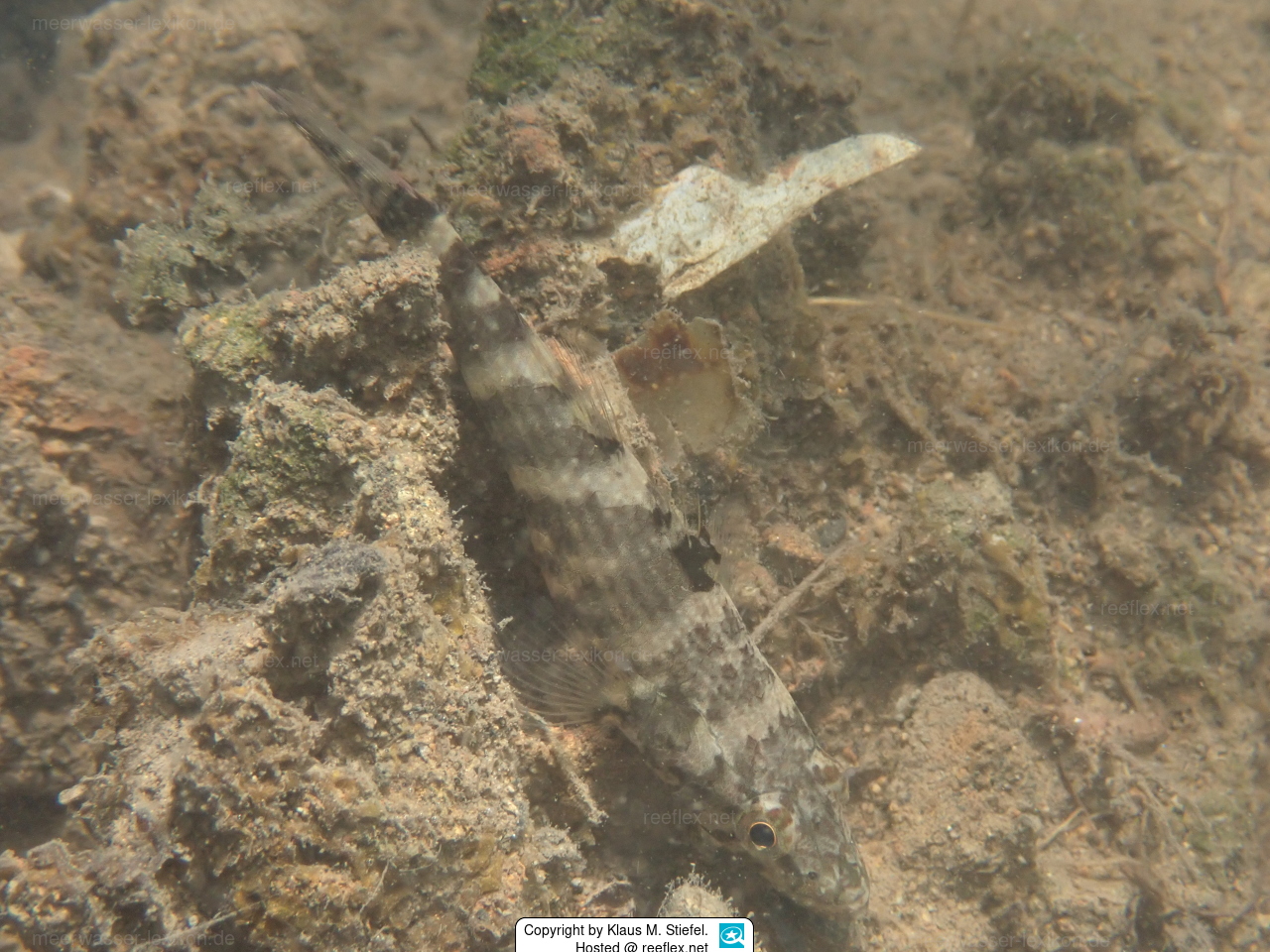Info
The Sharphead Goby (Butis butis) usually lives on muddy bottoms in nearshore marine and brackish water habitats, often amidst mangroves; also in the lower reaches of freshwater streams, although it prefers slower waters.
The goby is a sophisticated predator, feeding mainly on small fish and crustaceans.
The small predator likes to act from ambush and often "stalks" its prey by lurking upside down on sticks and floating leaves, then striking with lightning speed.
Butis is commercially traded and should be given an aquarium that is not too large, with sand as a substrate and stone structures or root hiding places.
Water values: PH value of 7 - 8.5 and a GH value of 9 - 19 °dGH.
The Sharphead Goby is a medium sized goby with a long, broad, flattened snout that almost looks like a scoop.
Although color is variable, the goby is often mottled brown with fine dark lines along the sides, a black caudal fin with a light upper margin, and 1 - 2 black spots at the pectoral fin base and reddish edges on the dorsal and anal fins.
Brief description:
Upper surface blackish to blackish brown, often lighter brown below head and on belly; sides with black lines following scale rows and pale brown spot in center of each scale; pattern on sides sometimes obscured by darker transverse spots; distinct dense black, sometimes double, spot in center of pectoral base bordered above and below by bright orange-red spots. Head with 3 - 5 oblique bars radiating from eyes, the most prominent bar running posteriorly across cheeks, another from front of eye to middle of upper jaw.
Dorsal fins blackish below and white above, first dorsal fin sometimes with orange to purple margin. Anal fin similar to first dorsal fin, sometimes with orange-red base stripe. Caudal fin blackish brown with oblique white covering only dorsal margin or up to nearly one-third of fin; lower margin sometimes red. Pelvis blackish, with white margins.
Goby should not be kept with other animals as it can become quite aggressive.
Please note: The animals need, depending on the origin, different salinity of the aquarium water, the animal should be acclimated slowly.
Jumping guard
A jumping guard prevents (nocturnal) fish from jumping out.
Wrasses, blennies, hawkfishs and gobies jump out of an unprotected tank in fright if their night rest is disturbed, unfortunately these jumpers are found dried up in the morning on carpets, glass edges or later behind the tank.
https://www.korallenriff.de/en/article/1925_5_Jump_Protection_Solutions_for_Fish_in_the_Aquarium__5_Net_Covers.html
A small night light also helps, as it provides the fish with a means of orientation in the dark!
The goby is a sophisticated predator, feeding mainly on small fish and crustaceans.
The small predator likes to act from ambush and often "stalks" its prey by lurking upside down on sticks and floating leaves, then striking with lightning speed.
Butis is commercially traded and should be given an aquarium that is not too large, with sand as a substrate and stone structures or root hiding places.
Water values: PH value of 7 - 8.5 and a GH value of 9 - 19 °dGH.
The Sharphead Goby is a medium sized goby with a long, broad, flattened snout that almost looks like a scoop.
Although color is variable, the goby is often mottled brown with fine dark lines along the sides, a black caudal fin with a light upper margin, and 1 - 2 black spots at the pectoral fin base and reddish edges on the dorsal and anal fins.
Brief description:
Upper surface blackish to blackish brown, often lighter brown below head and on belly; sides with black lines following scale rows and pale brown spot in center of each scale; pattern on sides sometimes obscured by darker transverse spots; distinct dense black, sometimes double, spot in center of pectoral base bordered above and below by bright orange-red spots. Head with 3 - 5 oblique bars radiating from eyes, the most prominent bar running posteriorly across cheeks, another from front of eye to middle of upper jaw.
Dorsal fins blackish below and white above, first dorsal fin sometimes with orange to purple margin. Anal fin similar to first dorsal fin, sometimes with orange-red base stripe. Caudal fin blackish brown with oblique white covering only dorsal margin or up to nearly one-third of fin; lower margin sometimes red. Pelvis blackish, with white margins.
Goby should not be kept with other animals as it can become quite aggressive.
Please note: The animals need, depending on the origin, different salinity of the aquarium water, the animal should be acclimated slowly.
Jumping guard
A jumping guard prevents (nocturnal) fish from jumping out.
Wrasses, blennies, hawkfishs and gobies jump out of an unprotected tank in fright if their night rest is disturbed, unfortunately these jumpers are found dried up in the morning on carpets, glass edges or later behind the tank.
https://www.korallenriff.de/en/article/1925_5_Jump_Protection_Solutions_for_Fish_in_the_Aquarium__5_Net_Covers.html
A small night light also helps, as it provides the fish with a means of orientation in the dark!







 Dr. Klaus M. Stiefel, Philippinen
Dr. Klaus M. Stiefel, Philippinen

